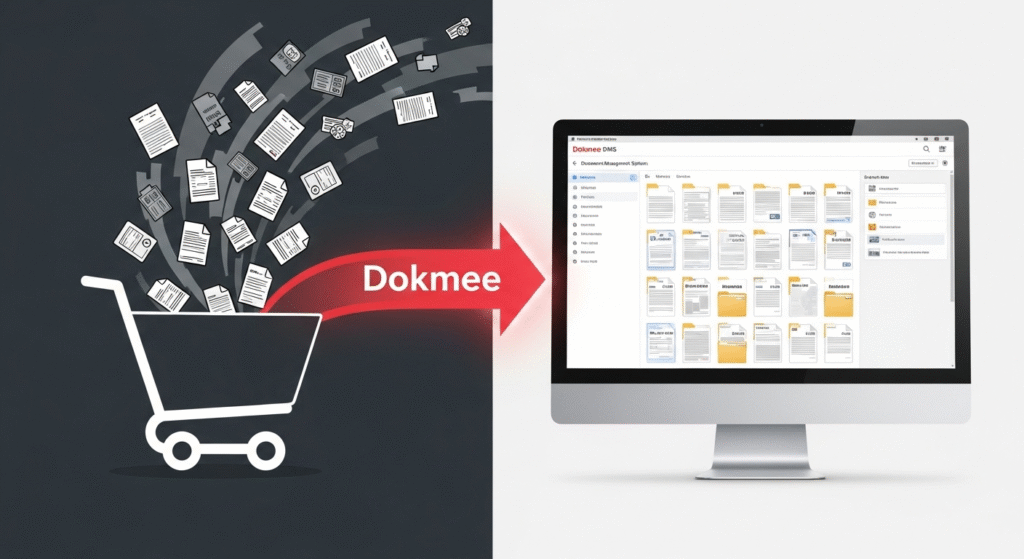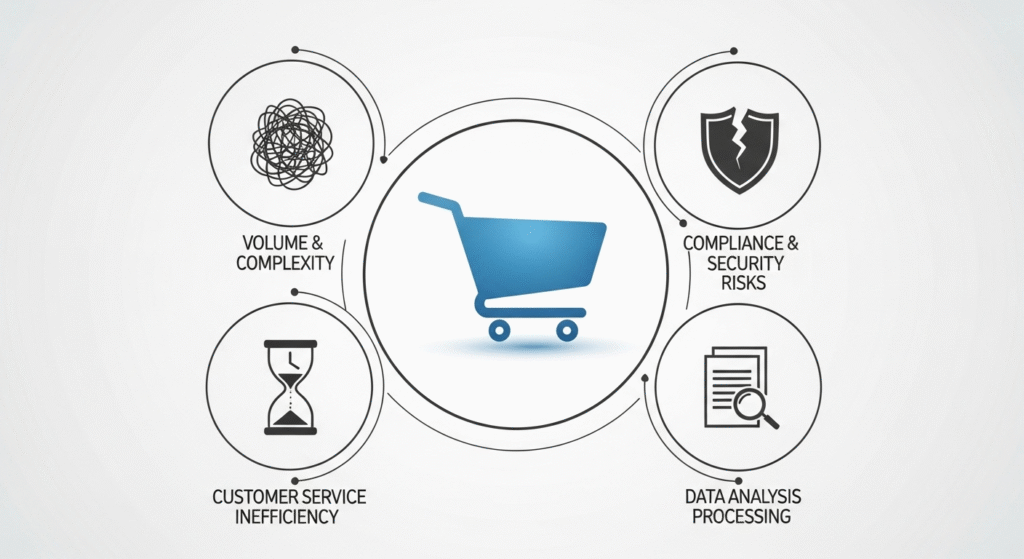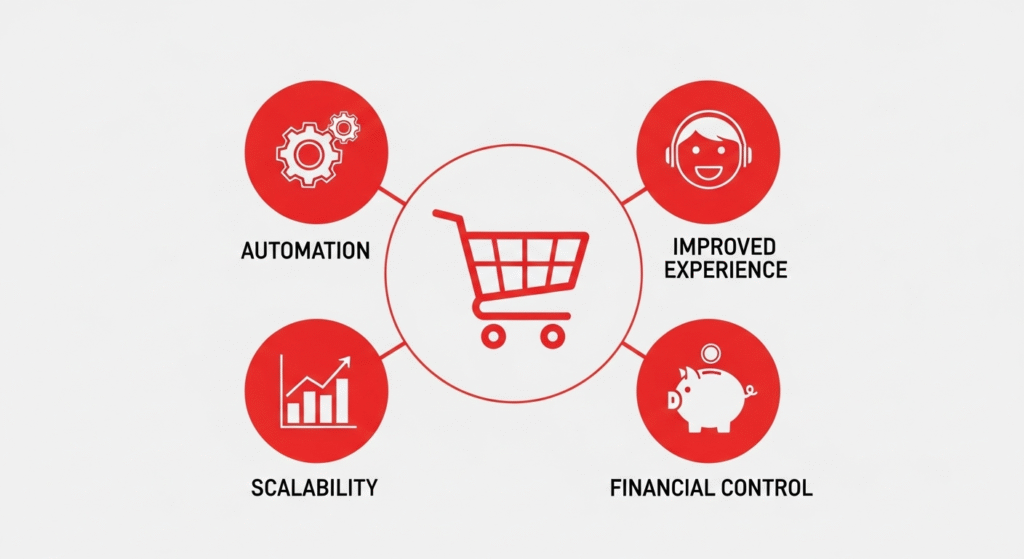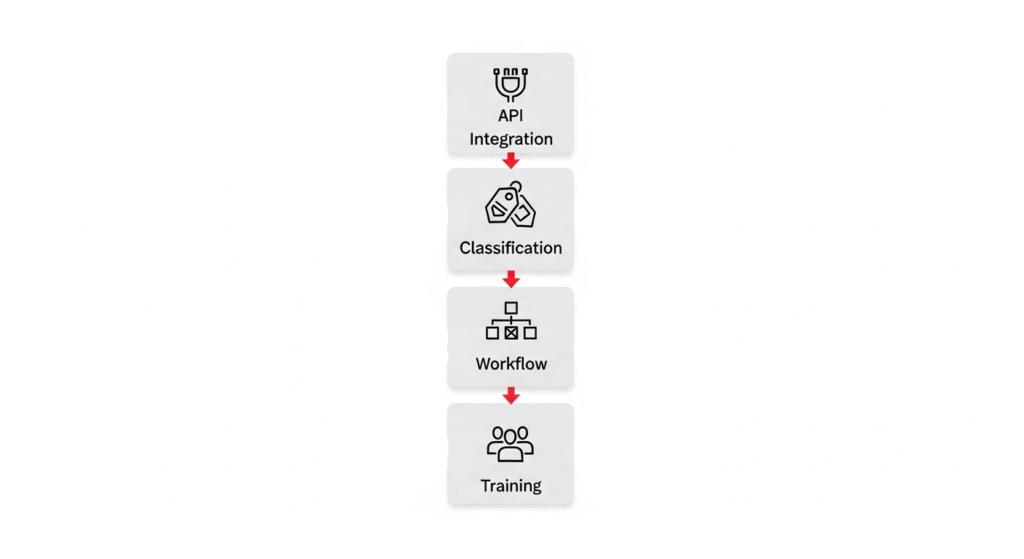
DMS for Human Resources: How Can a DMS Help HR?

An e-commerce DMS can automate order processing, manage invoices, and streamline operations. Check out this full implementation guide.
Your online store just hit 500 orders per day.
But your team is drowning in invoices, shipping documents, returns paperwork, and customer service tickets.
Every order generates multiple documents and finding the right document when customers call becomes a needle-in-a-haystack nightmare.
That’s where Document Management Systems (DMS) transform ecommerce operations from reactive document hunting to proactive automation that scales with your growth.
So, how exactly can a DMS help you organize your document chaos?
A Document Management System (DMS) is software that captures, organizes, stores, and manages all your business documents digitally.
For e-commerce, this means every invoice gets automatically filed and becomes instantly searchable when customers call with questions.

Your e-commerce DMS isn’t made for file storage only.
It integrates directly with your online store platform, whether you’re running on Shopify or a custom build. When orders come in, the system automatically creates documents and routes them through your approval workflows.
The real power comes from handling everything in one place.
Structured documents like invoices live alongside unstructured content like customer service emails, so you no longer need to hunt through scattered email accounts or cloud folders when you need specific information.
E-commerce businesses face document management challenges that traditional filing methods simply can’t handle.

Here are a few examples:
Online stores generate thousands of documents daily.
Your main website creates order confirmations. Marketplace listings produce their own paperwork. Customer service platforms throw in extra communications that need organizing.
Without systematic document management, your team wastes hours hunting for specific invoices or shipping confirmations. This inefficiency compounds as your business grows. Down the line, it creates bottlenecks that hurt your image and profit margins.
Modern e-commerce operations don’t live in only one place.
You might sell through your Shopify store while also managing Amazon listings and B2B wholesale portals. Each platform has its own document formats and naming conventions.
A proper DMS consolidates everything into one searchable system. You no longer have to hop between platforms when customers call with questions about their orders.
Different documents have different retention rules. Tax records need to stay for seven years. Payment card data falls under PCI DSS standards. Customer information has GDPR or CCPA requirements.
Your DMS automatically handles these retention policies through customized workflows and keeps audit trails. This systematic approach protects your business during audits and keeps customer data secure.
When customers call with order questions, your team needs complete order histories immediately. Manual file searching creates hold times that frustrate everyone involved.
Integrated DMS puts complete customer document histories at your team’s fingertips so that when your customers call, your team can focus on providing them with solutions instead of wasting time hunting for their documents.
This will help your customers leave feeling satisfied and assisted and not frustrated because they have been wasting their time.
Implementing a DMS in your ecommerce makes your business much more efficient and, more importantly, scalable.
And there are many more benefits that come with a DMS.

Your DMS automatically captures order confirmations from your e-commerce platform, generates invoices based on predefined templates, routes them through approval workflows, and archives completed transactions.
Essentially, what used to require manual steps at each stage now happens automatically, leading to a major reduction in manual document processing time within the first quarter after implementation.
Most e-commerce businesses implement such workflows already; the e-commerce automation market is projected to grow from $10.5 billion in 2024 to $28.5 billion in 2032, meaning these approaches are becoming an industry standard.
Customer service representatives access complete order histories instantly. Original purchases, shipping confirmations, return authorizations, and communication logs. This allows them to solve your clients’ problems faster and provide them with a more personalized service.
This noticeably improves response times, as they no longer have to search multiple systems for files. When your brand is known for providing excellent customer service, its rating will naturally skyrocket, meaning you will improve your reputation and trust, that leads to pulling more clients your way.
Automated invoice generation and approval workflows eliminate manual errors while maintaining proper authorization controls thanks to the DMS’ secure document management features.
Your accounting team gets organized, compliant documentation that streamlines month-end closing and audit preparation.
As order volumes increase, your document management scales automatically without additional manual processes. Documents get organized consistently according to your business rules regardless of whether you’re processing 100 or 10,000 orders per day.
This scalability becomes indispensable during peak seasons when manual document processing would otherwise require temporary staff increases, which comes with its own headaches.
Successful DMS implementation requires strategic planning around your existing e-commerce technology stack.

Here’s the general process:
Start by connecting your DMS with your primary e-commerce platform through APIs or webhooks. This integration ensures that order confirmations, customer data, and transaction records automatically flow into your document management system.
Configure your DMS to automatically classify incoming documents by type: invoices, shipping labels, customer service tickets, vendor contracts.
This way, appropriate workflows and retention policies are triggered whenever a document is captured without your manual intervention.
Next, set up automated naming conventions that include customer information, order numbers, and dates. This will help you locate any document in seconds, even as volumes grow exponentially.
Design approval workflows for different document types.
For example, purchase orders above certain amounts might require manager approval before processing, whereas returns might need quality assurance review before refund authorization.
These workflows replace ad hoc email approvals that take up your time with systematic processes that reduce approval delays while maintaining audit trails.
Train your team on new document workflows, focusing on how the DMS integrates with their existing tools rather than replacing familiar processes.
Customer service representatives should understand how to access customer documents from within your helpdesk system.
It’s better to roll out your implementations in phases instead of all at once. Start with order processing workflows, then expand to customer service, accounting, and vendor management.
Among its many capabilities, a DMS can handle many crucial tasks that will simplify your teams daily tasks.
What can a DMS do?
✔️ Generate and send customer invoices and payment confirmations
✔️ Set up automated workflows to notify team members at the exact time of their task
✔️ Manage return authorizations
✔️ Compile tax documents
✔️ Save detailed audit trails
A DMS like Dokmee can automate these processes, freeing up your team to focus on what actually grows your business: sales, marketing, and customer satisfaction.
Dokmee provides e-commerce businesses with enterprise-level document management capabilities designed specifically for online retail operations.
A DMS (Document Management System) in e-commerce is software that automatically captures, organizes, and manages all business documents generated by online sales—invoices, shipping labels, customer communications, and transaction records.
It integrates with e-commerce platforms to streamline document workflows.
No, DMS and CRM serve different functions. A Customer Relationship Management (CRM) system manages customer interactions and sales processes, while a Document Management System organizes and stores business documents.
However, they often integrate to provide complete customer information, including document histories.
DMS in the ERP context refers to the document management module within Enterprise Resource Planning systems. While ERP handles business processes like inventory and accounting, the DMS component manages the documents these processes generate: purchase orders, invoices, contracts, and compliance records.
DMS in sales refers to document management systems that organize sales-related paperwork: contracts, proposals, quotes, agreements, and customer communications. It streamlines sales workflows by automating document creation, approval processes, and archiving.